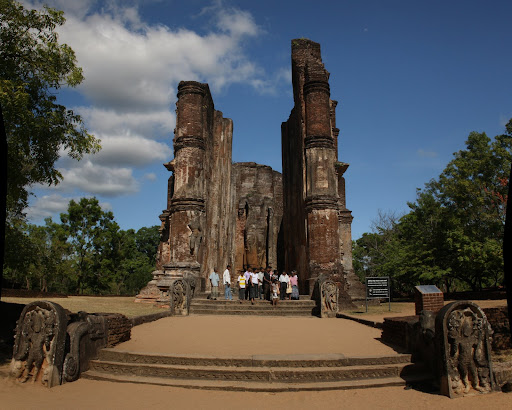The first of our train adventures in Sri Lanka was from Polonnaruwa to Trincomalee on the northeast coast. We certainly could have made the trip by bus but I had heard great things about train travel in Sri Lanka. I was determined to give the trains a try but doing so certainly required some effort.
There are a variety of Sri Lankan train schedules online and in the guidebooks but we determined that there is only one reliable way to figure the system out. You have to go to the station where you want to depart on the day before travel and ask the station master if there will be a train. If you talk to anyone else, or use any website for schedule information and you are almost guaranteed to be disappointed!
We set off from our guesthouse at 8AM by tuktuk to make the 20 minute drive over to Polonnaruwa’s new town where the train station is located. We were to catch the 9:24am train for Colombo, ride it for about an hour and then switch to a Trincomalee-bound train at Galoya Junction for another two hours on the rails. Simple.
Most Sri Lankan trains have 2nd and 3rd class seats and a few feature 1st class. The station master in Polonnaruwa told us that the Trinco trip was only available in 3rd class that day. Seemed OK to us as the total trip including the connection time was only about 5 hours. Total fare was 95 rupees ($0.90) per person, a steal!
While we waited in the station I had a good look around. The train system in Sri Lanka was built during the British colonial days and it remains much the same today. Taking a train trip in Sri Lanka is a bit like going to a museum and seeing all the old equipment that is still in use today was excellent.
The I-beams (discarded train track?) that was supporting the station roof was stamped “Carnegie Steel USA.” I found it pretty shocking to think that at one point in time the best way to get steel in rural Sri Lanka was to order it in from Pittsburgh! Roles are a bit reversed these days.
Once we arrived at Galoya junction we had about an hour to kill. The train to Trinco was already there but we had to wait for a northbound train from Colombo that had connecting passengers. I noticed that our train had one second class car tacked on the end so I asked about an upgrade.
A long conversion ensued in Sinhala between the two ticket clerks and the station master. Fare tables were consulted, distance charts were used, calculations were performed and double-checked. Finally, an excess fare form was pulled from a special binder and completed in carbon-copy triplicate. All the complexity stemmed from the fact that they were prorating our 2nd class fare based on the distance we had already traveled in 3rd class. We gladly would have paid for a completely new ticket but it seemed like they enjoyed the challenge. We happily ponied up the 55 rupee ($0.50) fare difference for the 2nd class ticket.
Exploring the station itself was good fun. There were monkeys sitting on the tracks waiting for handouts and a number of stray dogs milling about. The slender station building had all sorts of interesting rooms with signs labeling their purpose: “Carriage Examiner,” “Station Master’s Office,” “2nd Class Gents Waiting Room,” etc. I don’t know about other travelers but I get a great deal of enjoyment out of very orderly things like this when traveling in an otherwise chaotic locale.
Our train had about a half dozen cars in total and was pulled by a single diesel locomotive. I was pleased to find a plaque on the side of the locomotive that informed me that its name was “Alberta” and that it was a donation from the Canadian government. It performed well and got us to Trinco more or less on time.
We thoroughly enjoyed our first Sri Lankan train trip and aside from the fans not working in our 2nd class car, the ride was flawless. For me, it was infinitely more comfortable than the bumpy and cramped bus rides of days past and getting to experience a colonial relic of days past was icing on the cake.



